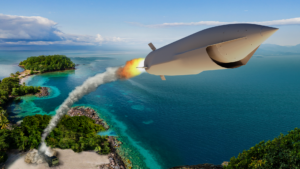Lockheed Martin [LMT] and a team of Raytheon Technologies
[RTX] and Northrop Grumman [NOC] will develop long-range missile concepts to inform the design of a future extended range version of the Army’s new Precision Strike Missile (PrSM), the firms said Monday.
Raytheon’s selection to work on the Long Range Maneuverable Fires (LRMF) design program signals its return to the PrSM effort after exiting the program in March 2020 during the initial competition against Lockheed Martin, which won the production contract.

“Our experience in developing the most sophisticated missile technologies in the world uniquely positions Raytheon to partner with the Army to address this high-priority modernization program,” Tom LaLiberty, Raytheon Missile and Defense’s president of land warfare and air defense, said in a statement. “This legacy, coupled with our creative partnerships to bring together proven technologies, enables us to deliver a superior solution that meets or exceeds the requirements for the critical long-range precision fires mission.”
Raytheon previously exited the PrSM program during the technology maturation and risk reduction phase without having conducted a flight test of its DeepStrike missile for the Army (Defense Daily, March 25 2020).
Lockheed Martin, which is currently producing increment PrSM Increment 1 missiles for the Army, said its design for LRMF will “employ unique design elements and key technologies to address size and endurance challenges” to meet the goal for reaching significantly extended ranges.
“We are developing and maturing an advanced propulsion solution that significantly extends PrSM’s range while retaining the ability to launch from U.S. Army launchers,” Brad Fiebig, Lockheed Martin’s director of tactical missiles advanced programs, said in a statement to Defense Daily.
Raytheon said its work with Northrop Grumman will include “co-design, build and test the propulsion subsystem for DeepStrike-ER, an advanced missile solution that will demonstrate the capability to achieve the Army’s desired range and effectiveness against next-generation threats.”
PrSM is the Army’s program to replace its legacy ATACMS missiles, also built by Lockheed Martin, with the base weapon reaching ranges up to 500 kilometers, while officials have noted future increments may push to double the capability’s range.
Fiebig noted LRMF is a science and technology effort to inform the design for PrSM Inc. 4, when the Army will go after extended ranges, and is not a separate capability to be fielded.
The Army’s Aviation and Missile Center, which selected the companies for the design effort, noted in a recent update in February that it had awarded Lockheed Martin a $33.3 million deal for “development and demonstration of long-range fires capability” and $97.7 million to Raytheon for “long-range precision fires air-breathing missile prototypes.”
Lockheed Martin said the first phase of LRMF is focused on design and risk-reduction activities, with the potential for flight test demonstrations as part of optional follow-on phases.
“Following flight tests, LRMF will transition to the U.S. Army’s Strategic and Operational Rockets and Missiles project office to inform the design of an extended-range PrSM Inc. 4,” Lockheed Martin said in a statement.
The Army’s FY ‘24 budget request detailed plans to buy 110 more PrSM Inc. 1 weapons and have first prototype delivery in the fourth quarter of next fiscal year (Defense Daily, March 13).